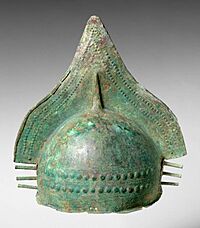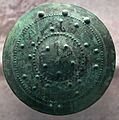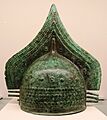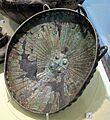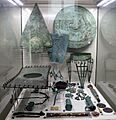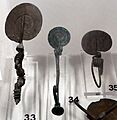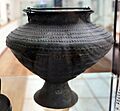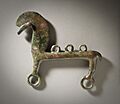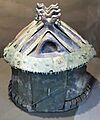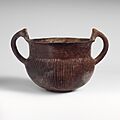Villanovan culture facts for kids
 |
|
| Geographical range | Europe (Italy: Emilia-Romagna, Tuscany, Lazio, Campania) |
|---|---|
| Period | Early Iron Age, Early phases of the Etruscan civilization |
| Dates | c. 900–700 BC |
| Preceded by | Proto-Villanovan culture |
| Followed by | Orientalizing period (later 700–500 BC) of the Etruscan civilization |
The Villanovan culture (c. 900–700 BC), regarded as the earliest phase of the Etruscan civilization, was the earliest Iron Age culture of Italy. It directly followed the Bronze Age Proto-Villanovan culture which branched off from the Urnfield culture of Central Europe. The name derives from the locality of Villanova, a fraction of the municipality of Castenaso in the Metropolitan City of Bologna where, between 1853 and 1855, Giovanni Gozzadini found the remains of a necropolis, bringing to light 193 tombs, of which there were 179 cremations and 14 inhumations.
The Villanovans introduced iron-working to the Italian Peninsula. They practiced cremation and buried the ashes of their dead in pottery urns of distinctive double-cone shape.
Contents
History
The name Villanovan of the early phases of the Etruscan civilization comes from the site of the first archaeological finds relating to this advanced culture, which were remnants of a cemetery found near Villanova (Castenaso, 12 kilometres east of Bologna) in northern Italy. The excavation lasting from 1853 to 1855 was done by the scholar and site owner, count Giovanni Gozzadini, and involved 193 tombs, six of which were separated from the rest as if to signify a special social status. The "well tomb" pit graves lined with stones contained funerary urns. These had been only sporadically plundered and most were untouched. In 1893, a chance discovery unearthed another distinctive Villanovan necropolis at Verucchio overlooking the Adriatic coastal plain.
The burial characteristics relate the Villanovan culture to the Central European Urnfield culture (c. 1300–750 BC) and Celtic Hallstatt culture that succeeded the Urnfield culture. It is not possible to tell these apart in their earlier stages. Cremated remains were placed in cinerary urns, specifically in biconical urns and then buried. The urns were a form of Villanovan pottery known as impasto. A custom believed to originate with the Villanovan culture is the usage of hut-shaped urns, which were cinerary urns fashioned like the huts in which the villagers lived. Typical sgraffito decorations of swastikas, meanders, and squares were scratched with a comb-like tool. Urns were accompanied by simple bronze fibulae, razors and rings.
Periodization
The Villanovan culture is broadly divided into Villanovan I from c. 960 BC to c. 801 BC and the Villanovan II from c. 800 BC to 720 BC. The later phase (Villanovan II) saw radical changes, evidence of contact with Hellenic civilization and trade with the north along the Amber Road. This evidence takes the form of glass and amber necklaces for women, armor and horse harness fittings of bronze, and the development of elite graves in contrast to the earlier egalitarian culture. Chamber tombs and inhumation (burial) practices were developed side-by-side with the earlier cremation practices. With the last phase of Villanovan II the Etruscans, in particular Southern Etruria, entered the Orientalizing period. The northernmost areas of the Etruscan world, such as Etruria Padana, continued in their development as Villanovan III (750–680 BC) and Villanovan IV (680–540 BC).
Villanovan chronology within the Etruscan civilization
| Etruscan civilization (900–27 BC) |
Villanovan period (900–720 BC) |
Villanovan I | 900–800 BC |
| Villanovan II | 800–720 BC | ||
| Villanovan III (Bologna area) | 720-680 BC | ||
| Villanovan IV (Bologna area) | 680-540 BC | ||
| Orientalizing period (720–580 BC) |
Early Orientalizing | 720–680 BC | |
| Middle Orientalizing | 680–625 BC | ||
| Late Orientalizing | 625–580 BC | ||
| Archaic period (580–480 BC) |
Archaic | 580–480 BC | |
| Classical period (480–320 BC) |
Classical | 480–320 BC | |
| Hellenistic period (320–27 BC) |
Hellenistic | 320–27 BC |
Metalwork and trade
The metalwork quality found in bronze and pottery demonstrate the skill of the Villanovan artisans. Some grave goods from burial sites display an even higher quality, suggesting the development of societal elites within Villanovan culture. Tools and items were placed in graves suggesting a belief in an afterlife. Men's graves contained weapons, armor, while those for women included weaving tools. A few graves switched or mixed these, indicating the possibility that some women employed tools and that some men made clothing.
During the Villanovan period Etruscans traded with other states from the Mediterranean such as Greeks, Balkans, and Sardinia. Trade brought about advancement in metallurgy, and Greek presence influenced Villanovan pottery.
Housing
Buildings were rectangular in shape. The people lived in small huts, made of wattle and daub with wooden poles for support. Within the huts, cooking stands, utensils and charred animal bones give evidence about the family life of early inhabitants in Italy. Some huts contained large pottery jars for food storage sunk into their floors. There was also a rock cut drain to channel rainwater to communal reservoirs.
Villanovan settlements
Generally speaking, Villanovan settlements were centered in the Adriatic Etruria, in Emilia Romagna (in particular, in Bologna and in Verucchio, near Rimini), in Marche (Fermo), and in the Tyrrhenian Etruria, in Tuscany and Lazio. Further south, Villanovan cremation burials are to be found in Campania, at Capua, at the "princely tombs" of Pontecagnano near Salerno, at Capo di Fiume, at Vallo di Diano and at Sala Consilina.
Small scattered Villanovan settlements have left few traces other than their more permanent burial sites, which were set somewhat apart from the settlements—largely because the settlement sites were built over in Etruscan times. Modern opinion generally follows Massimo Pallottino in regarding the Villanovan culture as ancestral to the Etruscan civilization.
Genetics
A genetic study published in Science in November 2019 examined the remains of a female from the Villanovan culture buried in Veio Grotta Gramiccia, Italy between ca. 900 BC and 800 BC. She carried the maternal haplogroup K1a4, found all over Europe since Neolithic times, and her autosomal DNA was a mixture of 72.9% Copper Age ancestry (EEF + WHG) and 27.1% Steppe-related ancestry. There was evidence for consanguinity for this sample with another ancient sample (700 BC - 600 BC) from the Etruscan necropolis of La Mattonara near Civitavecchia, compatible with being the latter an offspring of third-degree relatives from the former.
Gallery
-
Bronze Harness Trapping in the Shape of a Horse; Villanovan, 9th–8th century BC. LACMA
See also
- Etruscans
- Proto-Villanovan culture
- Urnfield culture
- Prehistoric Italy


